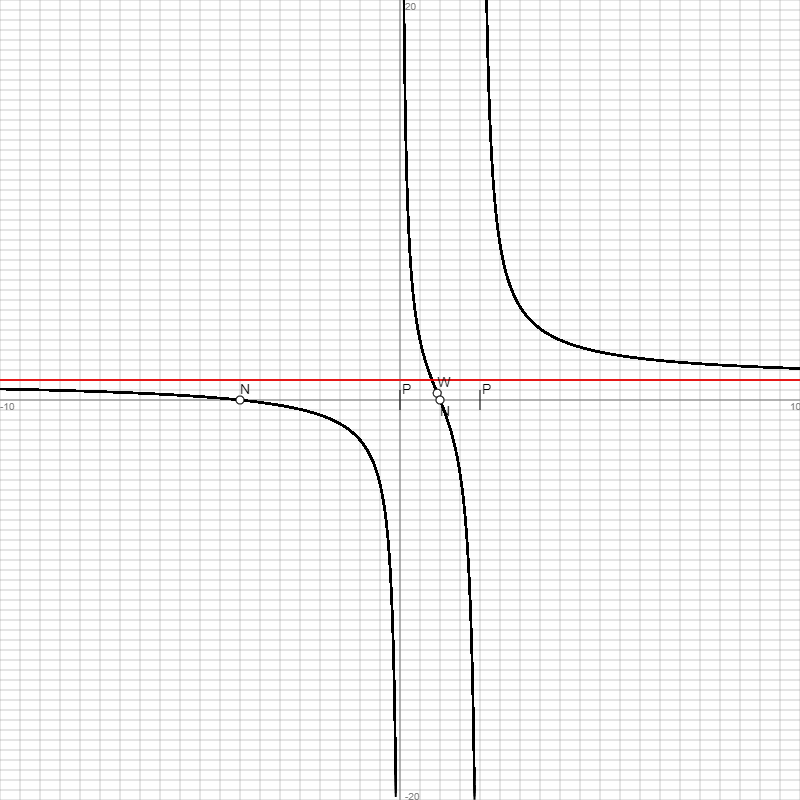 , Df = R\{0; 2}, Wf = R, gebrochen rationale Funktion (in Produkt-/Linearfaktordarstellung), x -> -∞: f(x) -> 1 = y als Grenzkurve, x -> +∞: f(x) -> 1 = y als Grenzkurve ->
, Df = R\{0; 2}, Wf = R, gebrochen rationale Funktion (in Produkt-/Linearfaktordarstellung), x -> -∞: f(x) -> 1 = y als Grenzkurve, x -> +∞: f(x) -> 1 = y als Grenzkurve ->www.michael-buhlmann.de
Funktion: f(x) =  , Df = R\{0; 2}, Wf = R, gebrochen rationale Funktion (in Produkt-/Linearfaktordarstellung), x -> -∞: f(x) -> 1 = y als Grenzkurve, x -> +∞: f(x) -> 1 = y als Grenzkurve ->
, Df = R\{0; 2}, Wf = R, gebrochen rationale Funktion (in Produkt-/Linearfaktordarstellung), x -> -∞: f(x) -> 1 = y als Grenzkurve, x -> +∞: f(x) -> 1 = y als Grenzkurve ->
| Wertetabelle: | |||||
| x | f(x) | f'(x) | f''(x) | f'''(x) | Besondere Kurvenpunkte |
| -10 | 0.55 | -0.04 | -0.01 | 0 | |
| -9.5 | 0.5286 | -0.04 | -0.01 | 0 | |
| -9 | 0.5051 | -0.05 | -0.01 | 0 | |
| -8.5 | 0.479 | -0.05 | -0.01 | 0 | |
| -8 | 0.45 | -0.06 | -0.01 | 0 | |
| -7.5 | 0.4175 | -0.07 | -0.02 | -0.01 | |
| -7 | 0.381 | -0.08 | -0.02 | -0.01 | |
| -6.5 | 0.3394 | -0.09 | -0.02 | -0.01 | |
| -6 | 0.2917 | -0.1 | -0.03 | -0.01 | |
| -5.5 | 0.2364 | -0.12 | -0.04 | -0.02 | |
| -5 | 0.1714 | -0.14 | -0.05 | -0.03 | |
| -4.5 | 0.094 | -0.17 | -0.07 | -0.04 | |
| -4 | 0 | -0.21 | -0.09 | -0.06 | Nullstelle N(-4|0) |
| -3.5 | -0.1169 | -0.26 | -0.13 | -0.1 | |
| -3 | -0.2667 | -0.34 | -0.2 | -0.18 | |
| -2.5 | -0.4667 | -0.47 | -0.32 | -0.35 | |
| -2 | -0.75 | -0.69 | -0.59 | -0.82 | |
| -1.5 | -1.1905 | -1.13 | -1.33 | -2.49 | |
| -1 | -2 | -2.33 | -4.22 | -12.25 | |
| -0.5 | -4.2 | -8.48 | -32.38 | -193.23 | |
| 0 | Infinity | Infinity | Infinity | Infinity | Senkrechte Asymptote/Pol x = 0 mit Vorzeichenwechsel: x -> 0-: f(x) -> -∞, x -> 0+: f(x) -> +∞ |
| 0.5 | 3 | -9.33 | 30.22 | -194.8 | |
| 0.932 | 0.3369 | -4.93 | 0 | -29.73 | Wendepunkt W(0.93|0.34) |
| 1 | 0 | -5 | -2 | -30.01 | Nullstelle N(1|0) |
| 1.5 | -3.6667 | -12.89 | -46.82 | -291.52 | |
| 2 | Infinity | Infinity | Infinity | Infinity | Senkrechte Asymptote/Pol x = 2 mit Vorzeichenwechsel: x -> 2-: f(x) -> -∞, x -> 2+: f(x) -> +∞ |
| 2.5 | 7.8 | -12.32 | 48.26 | -287.16 | |
| 3 | 4.6667 | -3.22 | 6.15 | -18.11 | |
| 3.5 | 3.5714 | -1.5 | 1.87 | -3.63 | |
| 4 | 3 | -0.88 | 0.81 | -1.17 | |
| 4.5 | 2.6444 | -0.58 | 0.43 | -0.49 | |
| 5 | 2.4 | -0.41 | 0.25 | -0.24 | |
| 5.5 | 2.2208 | -0.31 | 0.16 | -0.13 | |
| 6 | 2.0833 | -0.24 | 0.11 | -0.08 | |
| 6.5 | 1.9744 | -0.2 | 0.08 | -0.05 | |
| 7 | 1.8857 | -0.16 | 0.06 | -0.03 | |
| 7.5 | 1.8121 | -0.13 | 0.05 | -0.02 | |
| 8 | 1.75 | -0.11 | 0.04 | -0.02 | |
| 8.5 | 1.6968 | -0.1 | 0.03 | -0.01 | |
| 9 | 1.6508 | -0.09 | 0.02 | -0.01 | |
| 9.5 | 1.6105 | -0.08 | 0.02 | -0.01 | |
| 10 | 1.575 | -0.07 | 0.02 | -0.01 | |
| Graph: | |||||
 | |||||
Graph(en) der Asymptote(n), Grenzkurve(n).
Abkürzungen: Df = (maximaler) Definitionsbereich, f(x) = Funktion, f'(x) = 1. Ableitung, f''(x) = 2. Ableitung, f'''(x) = 3. Ableitung, H = Hochpunkt, L = Lücke, N = Nullstelle, P = Polstelle, R = reelle Zahlen, S = Sprungstelle, T = Tiefpunkt, W = Wendepunkt, WS = Sattelpunkt, Wf = Wertebereich, {.} = ein-/mehrelementige Menge, [.; .] = abgeschlossenes Intervall, (.; .) = offenes Intervall, [.; .), (.; .] = halboffenes Intervall, ∞ = unendlich.
Bearbeiter: Michael Buhlmann